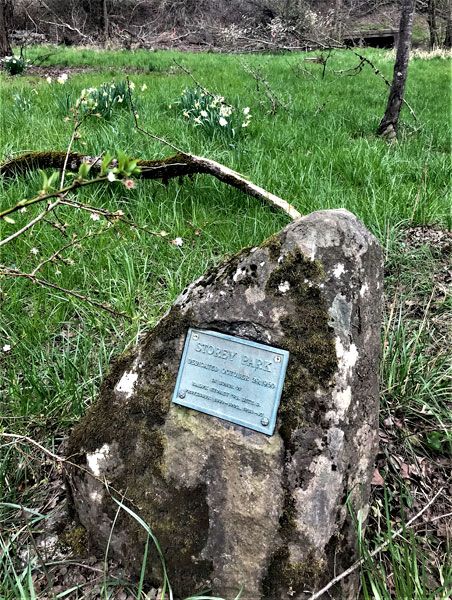Back, and Forth: Linfield campus plaques keep history grounded

Not all archives are dusty documents in some closet or digital files stored in the cloud.
Some archives you find at your feet, in the form of brass or marble markers, and when it comes to Linfield University’s ample number of such stones and plaques, I am happy to know I’m not alone in celebrating them.
I don’t know about Willamette or Pacific or other similar-sized schools, but I would hazard a guess that they do not rival Linfield for its wealth of historic markers.
Not long after arriving in McMinnville, I took regular walks around my alma mater, taking note of the commemorative plaques placed on pedestals or buildings, or next to trees. In some cases, the trees have grown over parts of the plaques installed 80 to 100 years ago, a poignancy I never fail to feel when I walk by them.
After making inquiries about some of the markers with the folks at Linfield, they put me in touch with Gretchen Freeman, who, with her husband, Mike, had in 2020 documented every Linfield-sponsored commemorative plaque on campus. Some are new and prominent; others are old, yet visible. Still others you have to look for, like one on the side of Melrose Hall and another down in the Cozine ravine, aka Storey Park.
But there is no need to go looking, for Freeman has done the work and she will be speaking about her project on Tuesday, April 18, in the latest Hillside Retirement Community speaker series, “Adventures in Learning.” Freeman’s talk, “Tracking Plaques on Linfield Campus: Sleuthing and Stories” will be at 2 p.m. in the Hillside Manor activity room. Admission is $5.
I’ve seen most of the plaques for myself, and have wondered about other objects on campus that may or may not be significant. Case in point is the stout old fountain in the Oak Grove directly across from Melrose. Today, it’s in such rough condition the birdbath-shaped object looks like it was dipped in an acid bath.
I figure that thing must have had a plaque on it at one time. It’s not alone in appearing neglected; Freeman’s project did not include public art pieces such as the one in front of Renshaw, large beams that hold a plaque rendered unreadable long ago by time and weather.
The Freemans did extensive research, including interviewing former President Charles Walker, and Marvin Henberg, author of the definite pictorial history of Linfield “Inspired Pragmatism.” Both vetted the inventory.
Gretchen explained to Linfield alum Tim Marsh, who authors the Wildcatville blog: “It grew from our countless walks on campus during the first year of COVID restrictions, when there were no students around. It led to about 60 hours of research to compile the documentation of 34 plaques. We also did narrated walking tours for groups of friends. All very interesting discoveries.”
The oldest plaque in the study is from 1895 — across the sidewalk on the north side of Pioneer. There, a horse chestnut still stands, planted that year as class tree. The newest, from 2017, honors student Parker Archie Moore, who was stabbed to death in 2014. It’s in addition to a bench across from Maxwell Field.
A few of my personal favorites are those partly overgrown by tree roots, dedicated to Harry Boardman, the first president of newly named McMinnville College (formerly Baptist College) and a similar ground-level one for Professor Ralph Storey, from the same turn of the 19th-to-20th-century era. The Boardman plaque is in the center of the Oak Grove, the Storey about 200 yards east, near Campbell Hall. I also like the Storey plaque in the Cozine ravine. While the trail is accessible from the north for those in sturdy shoes, fallen oaks from years ago effectively block anyone taking the full path. But the Storey plaque is easy to find, on a large boulder at the southwest corner of the meadow, and is a highlight of the Camas Festival walking tour. The second annual festival starts at 10 a.m. on Friday, May 5.
I enjoyed communicating with the Freemans about another marker, the Class of 1922’s engraved stone at the far northwest corner of the Oak Grove, just off the Baker Street sidewalk. Obscured for many years by undergrowth and moss, it is now easily visible and worth a stroll across the grove.
“We trimmed, scrubbed and de-mossed the 1922 monument in 2020 during our pandemic plaque project. It looked very neglected when we found it,” Gretchen told me in 2021.
“We turned over the attached document to the Linfield archives in November 2020 — it represents about 60 hours of work to locate, clean, photograph, research and document 34 plaques and honorees.” I consider it a fascinating insight to the history of the college-turned-university.
I knew nothing about any of these plaques when I was a student 44 years ago. No one mentioned them, and I never noticed them, at least not that I recall. I think the university should make the Freeman inventory available to all incoming freshmen as part of orientation, to help foster a sense of history in the place they have chosen to spend the next four years of their lives.
We grizzled alumni have our memories, such as they are, to look back upon, and our yearbooks. Perusing my father’s 1949 Oak Leaves recently, I found in its pages other vestiges of McMinnville history. The advertisers that year include a short list of businesses that are still going: Funeral Director Mr. Glen Macy, for one; his legacy endures at Macy & Son. First Federal is still here, as are Buchanan Cellers and Farnham Electric.
The Freemans note that it was Waldo Farnham who installed the classic lampposts on the Cozine trail — they are still there, still illuminated every night. I can recall a visit to Linfield with my dad in the 1960s and the footbridge that used to span the creek, later replaced — information also from the Freemans — with the bed of a truck. It’s the bridge that is there now.
I see Oak Leaves ads for both the Paragon Room coffee shop and Oregon Hotel, now McMenamins Hotel Oregon. And, of course, the News-Reporter, which would later be part of what is now the News-Register.
With the ads, I noticed a message from the Director of Admissions, a page containing a photo of something akin to the plaques. What’s shown in the 1949 photo is a bronze sundial. It’s an object I’d love to quiz Gretchen and others about. “Time is one of the valuable investments which the young person is making in a college education,” the admissions ad reads.
The sundial is a truly timeless symbol — the south face of Murdock Hall features one — but I have not seen the one in the photograph anywhere on campus. By its weathered surface, it looked like it was decades old in the mid-1900s.
I wonder what became of it. The sundial sat on a heptagonal pedestal, and its surface bore this inscription: “My face marks the sunny hours/What can you say about yours.”
The question mark is missing, either forgotten or deemed unnecessary. More of a statement than an inquiry, and with the lack of punctuation, the pithy 12-word saying reads like a Teddy Roosevelt-era meme.
Contact Kirby Neumann-Rea at kirby@newsregister.com or 503-687-1291.









Comments